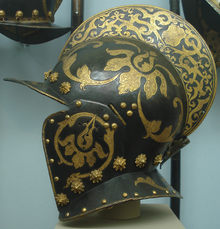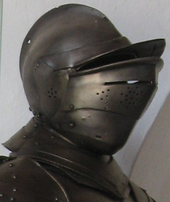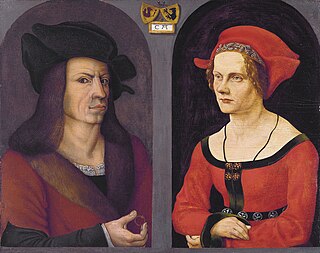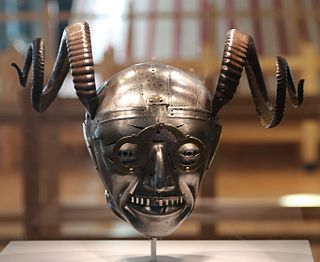
The burgonet helmet (sometimes called a burgundian sallet) was a Renaissance-era and early modern combat helmet. It was the successor of the sallet. [1]

The burgonet helmet (sometimes called a burgundian sallet) was a Renaissance-era and early modern combat helmet. It was the successor of the sallet. [1]

The burgonet helmet is characterised by a skull with a large fixed or hinged peak projecting above the face-opening, and usually an integral, keel-like, crest or comb running from front to rear. Attached to the skull are substantial hinged cheekpieces which usually do not meet at the chin or throat. A flange projects from the lower parts of the skull and cheekpieces to protect the back and sides of the neck. Though typically a relatively light helmet and open faced, a falling buffe, a sort of visor that was closed by being drawn up rather than down, was sometimes used. Some helmets, often termed "close burgonets", were made which took elements, such as the peak, crest and falling buffe, of the burgonet and combined them with the hinged bevor of the close helmet. [2] [3] [4]
Commonplace throughout Europe, it first came into use early in the 16th century and had attained its classic form by c. 1550. [5] Accompanied by plate armour, burgonets were mostly worn by cavalry, such as demi-lancers and cuirassiers.
The Border Reivers, of the English-Scottish borderlands, were very fond of burgonets and the morion in Elizabethan times, and as a result reivers were often called steil (steel) bonnets. [6] [7]
Burgonets were also a popular helmet type among the Polish winged hussars, where they merged with types of lobster-tailed pot helmets (Zischägge), often featuring a nasal bar or facial guard.
The burgonet was common among the mercenary Swiss infantry who were pikemen who could defend themselves against cavalry (perhaps taking helmets of this form as trophies). Following the appearance of the Stahlhelm, Adrian, and Brodie helmets during the First World War, the Swiss experimented with a "streamlined" form of the burgonet for their own national helmet, but both designs were rejected.
The factors of utility of the burgonet over older helmets include:

A rondel dagger or roundel dagger is a type of stiff-bladed dagger used in Europe in the late Middle Ages, used by a variety of people from merchants to knights. It was worn at the waist and could be used as a utility tool, or worn into battle or in a jousting tournament as a side arm.
A visor was an armored covering for the face often used in conjunction with Late Medieval war helmets such as the bascinet or sallet. The visor usually consisted of a hinged piece of steel that contained openings for breathing and vision. Appropriately, breaths refers to the holes in the metal of the visor. Visors protected the face during battle and could be remarkably durable. One surviving artifact was found to be "equivalent in hardness to cold worked high speed steel."

The sallet was a combat helmet that replaced the bascinet in Italy, western and northern Europe and Hungary during the mid-15th century. In Italy, France and England the armet helmet was also popular, but in Germany the sallet became almost universal.

The bascinet – also bassinet, basinet, or bazineto – was a Medieval European open-faced combat helmet. It evolved from a type of iron or steel skullcap, but had a more pointed apex to the skull, and it extended downwards at the rear and sides to afford protection for the neck. A mail curtain was usually attached to the lower edge of the helmet to protect the throat, neck and shoulders. A visor was often employed from c. 1330 to protect the exposed face. Early in the fifteenth century, the camail began to be replaced by a plate metal gorget, giving rise to the so-called "great bascinet".

The armet is a type of combat helmet which was developed in the 15th century. It was extensively used in Italy, France, England, the Low Countries and Spain. It was distinguished by being the first helmet of its era to completely enclose the head while being compact and light enough to move with the wearer. Its use was essentially restricted to the fully armoured man-at-arms.

The great helm or heaume, also called pot helm, bucket helm and barrel helm, is a helmet of the High Middle Ages which arose in the late twelfth century in the context of the Crusades and remained in use until the fourteenth century. The barreled style was used by knights in most West European armies between about 1220 to 1350 AD and evolved into the frog-mouth helm to be primarily used during jousting contests.

A barbute is a visorless war helmet of 15th-century Italian design, often with a distinctive T-shaped or Y-shaped opening for the eyes and mouth.

Lobster-tailed pot helmet, also known as the zischägge, horseman's pot and harquebusier's pot, was a type of combat helmet. It was derived from an Ottoman Turkish helmet type. From c. 1600, it became popular in most of Europe and was especially worn by cavalrymen and officers. The helmet gradually fell out of use in most of Europe in the late 17th century; however, the Austrian heavy cavalry retained it for some campaigns as late as the 1780s.

Maximilian armour is a modern term applied to the style of early 16th-century German plate armour associated with, and possibly first made for the Emperor Maximilian I. The armour is still white armour, made in plain steel, but it is decorated with many flutings that may also have played a role in deflecting the points and blades of assailants and increasing the structural strength of the plates. It is a transitional stage in the decoration of armour, after the plain steel surfaces of 15th-century armour and before the elaborate decoration and colouring with etching and other techniques of Renaissance armour. The armour is characterized by armets and close helmets with bellows visors; small fan-shaped narrow and parallel fluting—often covering most of the harness ; etching; work taken from woodcuts; sharply waisted cuirasses, and squared sabatons.

A bevor or beaver is a piece of plate armour designed to protect the neck, much like a gorget.

The nasal helmet was a type of combat helmet characterised by the possession of a projecting bar covering the nose and thus protecting the centre of the face; it was of Western European origins and was used from the late 9th century to at least c. 1250.

A morion is a type of open-faced combat helmet originally from the Kingdom of Castile (Spain), used from the beginning 16th to early 17th centuries, usually having a flat brim and a crest from front to back. Its introduction was contemporaneous with the exploration of North, Central and South America. Explorers such as Hernando de Soto and Coronado may have supplied them to their foot soldiers in the 1540s.
Gothic plate armour was the type of steel plate armour made in the Holy Roman Empire during the 15th century.

The close helmet or close helm is a type of combat helmet that was worn by knights and other men-at-arms in the Late Medieval and Renaissance eras. It was also used by some heavily armoured, pistol-armed cuirassiers into the mid-17th century. It is a fully enclosing helmet with a pivoting visor and integral bevor.

Greenwich armour is the plate armour in a distinctively English style produced by the Royal Almain Armoury founded by Henry VIII in 1511 in Greenwich near London, which continued until the English Civil War. The armoury was formed by imported master armourers hired by Henry VIII, initially including some from Italy and Flanders, as well as the Germans who dominated during most of the 16th century. The most notable head armourer of the Greenwich workshop was Jacob Halder, who was master workman of the armoury from 1576 to 1607. This was the peak period of the armoury's production and it coincided with the elaborately gilded and sometimes coloured decorated styles of late Tudor England.

The Helmschmied family of Augsburg were one of late medieval Europe's foremost families of armourers. Their name, sometimes also spelled Helmschmid, translates to helmet smith. The family's most prominent members were Lorenz Helmschmied, Kolman Helmschmied (1471–1532) and Desiderius Kolman Helmschmied (1513–1579).
Claude Blair, was a British museum curator and scholar, who specialised in European arms and armour. He is particularly known for his book European Armour: circa 1066 to circa 1700 (1958). He worked in the Royal Armouries at the Tower of London from 1951 to 1956, before moving to the Department of Metalwork at the Victoria and Albert Museum, where he remained until his retirement as Keeper of Metalwork in 1982. He was active in church conservation, and served as a Vice-President of the Society of Antiquaries of London from 1990 to 1993.
Ian Donald Dietrich Eaves,, is a British researcher and consultant on arms and armour. He served as the Keeper of Armour at the Royal Armouries for eighteen years, from 1978 to 1996. Also starting in 1978, and continuing until 1983, he served as the editor of the Journal of the Arms & Armour Society; he was appointed the society's president in 1995, and currently serves as a vice-president emeritus. He has written and translated several articles for journals, including the society's.

A standard, also called a pizaine, was a collar of mail often worn with plate armour.

The horned helmet of Henry VIII is the surviving part of a full suit of armour made by Konrad Seusenhofer between 1511 and 1514. The armour was a gift from the Holy Roman Emperor Maximilian I to the English king Henry VIII, following their alliance in the War of the League of Cambrai. The suit was elaborate and intended for display at tournament parades. It is unclear who was the intended wearer of the armour, but it appears to have been modelled on one of Henry's court fools. Henry may have worn the armour as a jest. The helmet has protruding eyes and a toothy grimace and is adorned with horns and spectacles. The helmet survived when the rest of the suit of armour was scrapped, probably after the English Civil War, and it is now in the collection of the Royal Armouries Museum in Leeds, which formerly used it as a symbol of the museum.